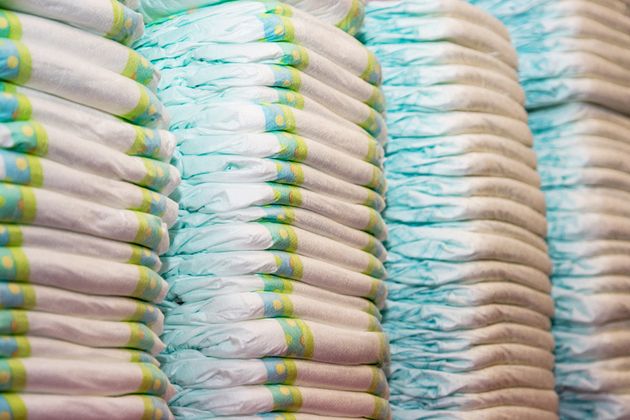
New parenthood is wrapping up warm nappy parcels of gloopy liquid gold. Such glamour can be overwhelming and I couldn’t face washable nappies when I first became a mum. Surviving through sleep deprivation and breastfeeding pain/guilt/leaks was challenging enough without the idea of washing nappies too. I imagined spending my evenings scrubbing sticky poo, elbow deep in a shit storm rather than enjoying a glass of something on the sofa with my feet up. Disposables are so convenient. Wrap it. Bin it. Forget it. Everyone else used disposables and it seemed like far too much hard work and a lot of extra money to try real nappies. Our baby’s first years came and went in disposables, adding over 4000 nappies to landfill and possibly 10,000 baby wipes. Plastic-wrapped poo left to rot for the next 450 years.
When my second was born, I was in a better place to give cloth nappies a go. I’d heard more about their environmental benefits and was keen to try. Plus, by now, our laundry was already monumental and a lidded nappy bucket couldn’t be worse than a nappy bin. We benefited from a local council scheme, receiving a reusable nappy starter pack worth £100. The upfront cost can be huge, so these schemes are exactly what all families need as an incentive to try it. Councils have to spend a lot of money to deal with disposable waste so it makes good sense for local government to encourage reusable alternatives.
Our first experience with real nappies was positive and so much easier, more convenient and far less mucky than I imagined. They look and work just like a disposable with Velcro tabs instead of plastic tape. Once soiled, the cloth nappies go straight into the mesh bag that lines a lidded bucket. When the baby’s older, you simply lift/shake the poo off the nappy liner and flush it down the loo. When full, pick up the bag and bung it in the washing machine. They take about a day to line-dry outside and then you prepare them to be used again. And again. And again. And eventually passed down to siblings, loaned or sold. A big regret of is not using them sooner.
We now use real nappies day and night, including our toddler who’s dry during the day but needs a pull-up at night. If he’s still dry by morning, I just hand-rinse the cloth rather than put a dry disposable into the bin. We’ve gathered a stash big enough to reduce washing to twice a week.
Since finding the best nappies to fit our children’s needs, we’ve had very few leaks and can say with certainty that cloth nappies last longer at night than disposables, despite regular milk feeds. Since switching to cloth, we’ve not experienced any nappy rash and therefore don’t need thick creams from the chemist. Kids in cloth are usually ready to use a potty earlier, too, as they are more aware of when they’re wet. There are many UK-based companies whose nappies range in size, style, price and materials, all commanding a fan-base of #clothbum-clad babes, modelling the latest cute design on their parents’ social media sites. The planet seems to like real nappies too, avoiding the thousands of nappies sent to landfill, escaping those leaking chemicals and extra methane.
Despite all the benefits, there’s a few drawbacks to consider, too. The washing process is energy-zapping, for both the machine and me. I’ve fallen off the washing wagon twice in four months and had to reach for a couple of disposables until I resumed my laundry groove. But these dark days in disposables remind me why I’m sticking with cloth: the nappy rash returns, sunshine yellow poo jettisons up the back, they’ve usually leaked by 2am and they are more smelly. The extra time it takes to prepare the nappies can seem a lot after a long day in Motherville. When you’re not getting much sleep or free time, this can feel beyond tedious. However, there’s also something wonderfully meditative about preparing soft fluffy nappies and it’s hugely satisfying to pile up a stash of ready-to-go cloth, in their rainbow glory, all while bingeing on your latest Netflix fix. But worst of all, if you’re regularly washing a half-load of microfibre at a high temperature and tumble drying, the carbon emissions may be costing the earth a lot, not to mention the energy bill and risking fragments of micro-plastics entering our oceans. The best way to decrease these hidden costs is to reserve the hot wash for the heavily soiled, to choose natural fibres and to avoid tumble drying (but then you’ll need more as bamboo and hemp take a lot longer to dry). This should keep the nappies performing at their best too.
Having originally feared the worst of washable nappies, I am now well and truly in the cult of cloth, a certified #clothbummum. I take pride in our colourful real nappy stash and have finally learnt what all the washing symbols mean. I’ve joined Facebook groups where we trouble-shoot various issues and swoon over the latest prints; we could literally chat shit all day. So what’s the reality of real nappies? The extra washing is daunting but even one real nappy a day can reduce your landfill waste by a thousand nappies. It’s a soft bundle of fluffy goodness that’s better for the planet and actually a better performer than you could ever hope for.
Follow Rebecca’s blog and Facebook page, The Night Feed: Parenting and Travel in the Slow Lane.